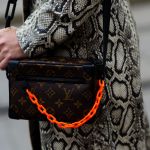
What is Luxury today?
Looking for a definition
December 19th, 2019
Shezi Manezi
In a visionary article published in 1995 on Vogue US, the journalist Mary Tannen compared Chanel's boutique on the Fifth Avenue with a brand new SoHo skate shop that had opened its doors just a year before, the shop was called Supreme. The Chanel’s boutique was the temple of luxury shopping, with glittering windows, tuxedo bouncers, frequented by the New York upper class who paid thousands of dollars for a French designer bag. The Skate shop instead was an hang out spot for skaters in one of the most derelict streets of Manhattan: the clerks would try to kick you out, the jeans and t-shirts could look like any other skate shop, but for the skaters perched on the tables outside the windows the white Supreme tee was worth more than the clutches signed with the double C. Tannen had understood that the concept of "luxury" worked in the same way for the Chanel shoppers and the skaters outside Supreme. In 1995 the Supreme case was a fairly sensational exception but after 25 years it is fair to put in the same category of “luxury brands” Chanel, Supreme, Off-White even Nike.
The key to the heart of a new luxury consumer is personal relevance. In today’s world, no brand has an eternal right to claim its luxury status, which is why no brand can afford to rest on its laurels. It is a fluid definition that changes depending on the perspective and does not accept rigid boundaries of fashion: the logo or the artisan quality do not define luxury, rather they are the values that the brand communicates and how each individual manages to adapt them to his own personality.
To be relevant today, every luxury brand must constantly look for new and refreshing ways to contextualise the old within the new. If traditional luxury brands had the main function of expressing the social status held within a society, today it is a means to express one's personality and position oneself in a social ecosystem. The paradigm is shifting from exclusivity to inclusivity. Simply put, luxury is no longer a concrete form of elitism, but more about recontextualization.
According to Jian DeLeon, editor of Highsnobiety and author of The New Luxury - a monograph accompanied by interviews among others with Kim Jones, Virgil Abloh and Hiroshi Fujiwara - contemporary luxury is the possibility of choice:
People are choosing what luxury is today. Where to eat, where to stay, how they go around look at Tesla. It’s an evolution of the jet-set, It’s hard to tell what luxury looks like today cause people in first class wear Uniqlo.
What looked like a provocative trend started by Dapper Dan first and James Jebbia bootlegging luxury logos in the 80s and the 00s, it’s today’s key to understand why Kanye, A$AP Rocky and Tyler, The Creator have become the icons of world style, Prada collaborates with adidas, Gucci made diversity her own main value, why the sneakerhead community exists and is obviously also the reason why Virgil Abloh is the creative director of Louis Vuitton. It is a matter of redefining the boundaries of a culture, mixing high and low so as to offer consumers a means of expressing their identity.
Virgil Abloh’s rise to Vuitton and Shawn Stüssy’s partnership with Dior do not mean that streetwear has become elevated, but that luxury is now a level playing field. The most important lessons from streetwear aren’t business practices like drop models or collaborations, nor is it about the timeless aesthetics of sportswear and military staples. Rather, its legacy is tied to establishing shared values grounded in a strong, self-assured brand identity.
The younger consumer had a pivotal role in this shift. Big brands changed the demographic of their target wants to buy things to feel validated. The average age of those who buy luxury is falling fast, Bain & Caompany has estimated that by 2025 about 45% of the luxury market will consist of Millennials and Gen Z. Other studies have shown that younger consumers are more inclined to spending one's money on experiences rather than on products, or living experiences that define identity through objects. Taking this definition to excess, we can say that the New Luxury has an immaterial value much higher than traditional luxury, but there is more. What’s different is the consumers increasingly realize the power they possess as tastemakers in their own right. More and more, brands and designers aren’t the dominant dictators of what’s relevant, but have become entities that provide the tools for individual self-expression. Additionally, this consumer also wants to feel a sense of belonging with shared ‘insider knowledge.’ Thanks to the proliferation of social media, an increasingly interconnected world changed the language of global consumption. It collapsed seeing things and buying things into one plane and made fashion a spectator sport. The rise of platforms like Instagram further removed the establishment’s power to dictate trends and tastes, allowing independent creators and labels to captivate audiences without the need to court traditional retailers and magazines.
Old vs New Luxury
The show, “” was produced in partnership with the Musée des Arts Décoratifs in Paris and curated by that museum’s director, Olivier Gabet. Running through Feb. 18, There are few logos, however (bar the LV Monogram pattern seen at one stage on a 1920s Louis Vuitton steamer trunk). And, glaringly, there is no focus on the modern global luxury moneymaking machine, or on the socia
Fashion is the sector that has redefined the meaning of luxury, overturning the creative process, but art is the most suitable but art is the most suitable instrument for looking at the evolution of contemporary luxury. At the Louvre Abu Dhabi, the exhibition 10,000 Years of Luxury, tries to chart some of the conflicting interpretations of luxury that have emerged over 10 millenniums. It explores the changing relationship between beauty and value across civilizations through 350 objects, grouping treasures or influential turning points in how societies have used and thought about luxury. The penultimate room features dozens of looks, from gowns to a sneaker, by many of the most famous names and dominant luxury brands in operation today, cataloging the growing creative tension in luxury between simplicity and excess, and the commercial spending power of modern women.
In the last room of the exhibition there is an installation sponsored by Cartier that represents the current definition and future luxury: it is a closed glass environment in which a spiral staircase is positioned that ascends upwards, to which it can access one person at a time. A cloud of perfume is suspended in the middle of the room The suspended Envol by Cartier that only those who have access to the installation can enjoy.

In the same way, traditional fashion finds it hard to find the meaning of camp-outs outside for Supreme or sneaker releases: the luxury product becomes the means to live an experience, whereas previously it was the end. For this reason we have tried to extract from the book The New Luxury this explanatory scheme that tries to define the difference between the old and the new luxury:
| Old Luxury | New Luxury |
| defined by price points | defined by knowledge |
| Aspiration is about price | Aspiration is about cultural value |
| Lo Items are special because they're exclusive to a certain set of people | Items are special because they're unique to the individual |
| Status is demonstrated by ownership of luxury items | Il Status is demonstrated by access to cultures |
| Luxury is something that you can bought | Luxury is dynamic lifestyle that requires participation |
| Physical stores are the truest manifestation of luxury | A brand's identity and values must be felt in digital and physical form |
| Value is tied solely to artisanal manufacturing | Value is tied to artful ideas executed at a high level |












































































